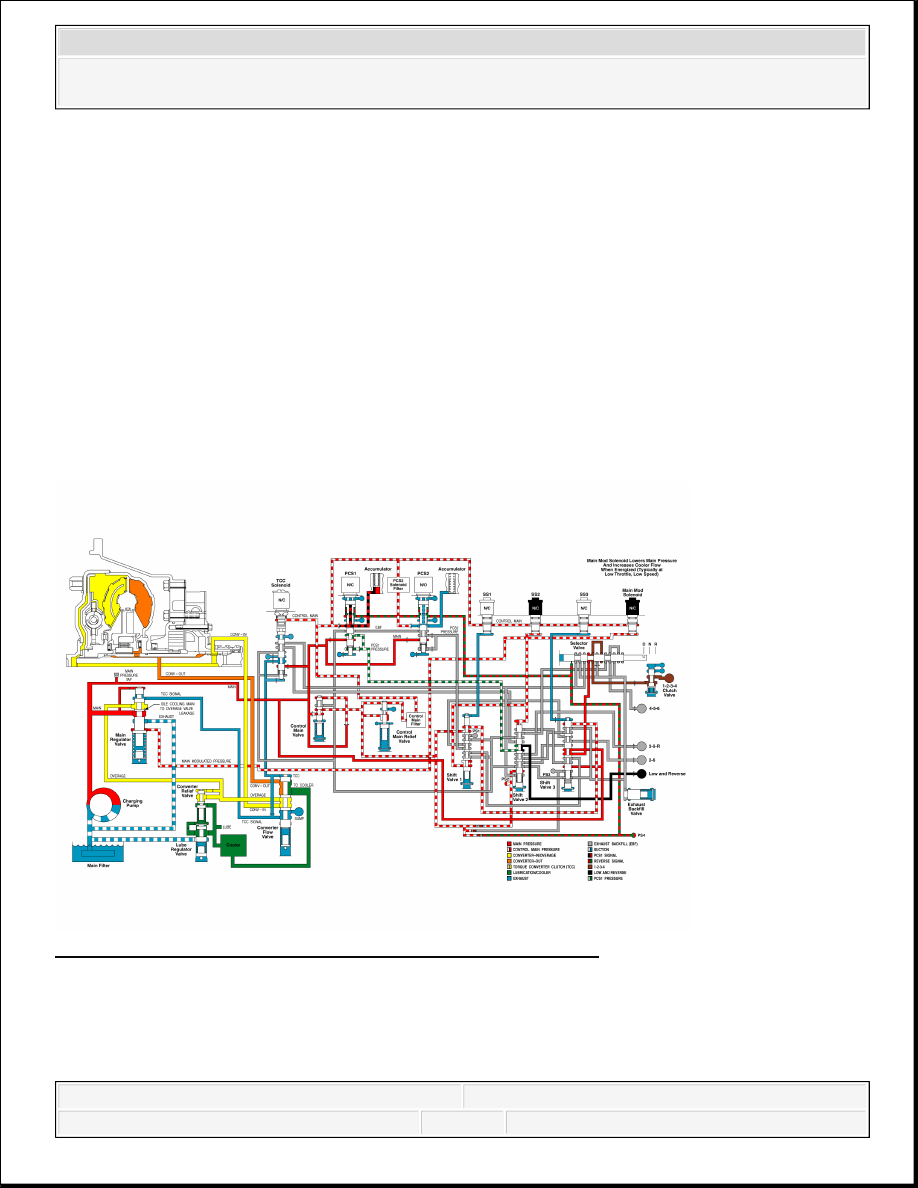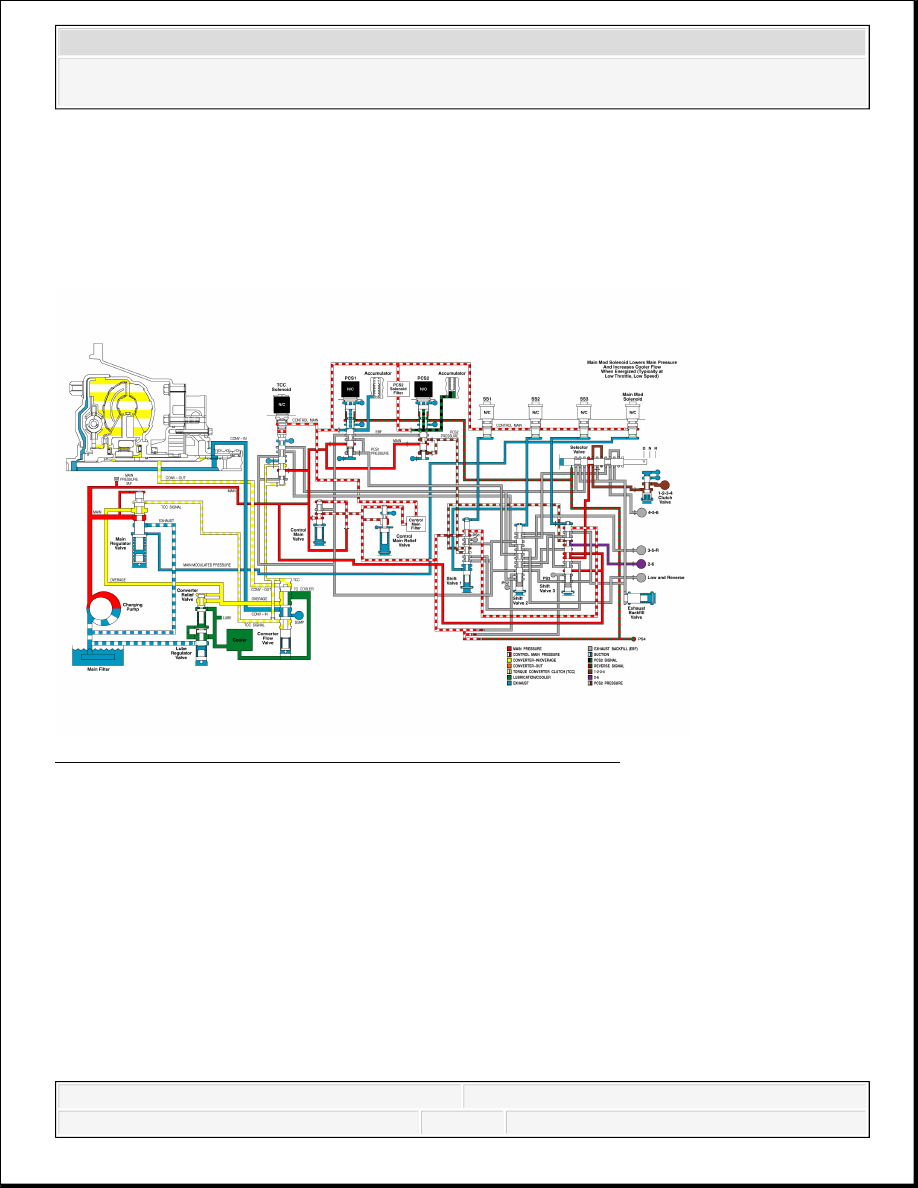Content .. 1000 1001 1002 1003 ..
Chevrolet Silverado / GMC Sierra. Manual - part 1002
pressure port to main pressure. PCS2 pressure is directed through shift valve 1, shift valve 3, and
the manual selector valve to the 1-2-3-4 clutch, applying the 1-2-3-4 clutch. The transmission
control module (TCM ) provides current to PCS2, which controls the rate of pressure buildup of
the 1-2-3-4 clutch, assuring a smooth transition to first range. The combination of the 1-2-3-4
clutch and the low and reverse clutch application produces first range operation.
After the shift to first range is complete, SS3 is de-energized followed closely by SS1 (timed to
prevent SS3 from becoming "latched" down), allowing both valves to de-stroke. PCS2 is also de-
energized, exhausting PCS2 signal pressure, allowing the pressure control valve 2 to de-stroke
which exhausts PCS2 pressure. In the de-stroked position, shift valve 3 routes main pressure to
the manual selector valve which directs the main pressure to the 1-2-3-4 clutch, keeping the 1-2-
3-4 clutch applied. With the 1-2-3-4 clutch and the low and reverse clutch applied, the
transmission stays in first range.
Control main pressure exhaust for pressure switch 2 is blocked by shift valve 2, keeping the
switch turned on and providing feedback to the TCM that shift valve 2 is stroked. With shift valve
1 in the de-stroked position, the pressure feed to pressure switch 1 is eliminated and with the
pressure exhausted, the pressure switch turns off, providing feedback that shift valve 1 is in the
de-stroked position. With shift valve 3 de-stroked, the control main pressure to pressure switch 3
is exhausted and pressure switch 3 turns off, providing feedback that shift valve 3 is in the de-
stroked position.
If electrical power is interrupted while the transmission is in first range, SS2 is de-energized.
Normally closed PCS1 continues to block the exhaust of PCS1 signal pressure (signal pressure
remains control main) which results in maximum PCS1 pressure being maintained. PCS1 pressure
continues to be directed to shift valve 2, which stays stroked due to the "latching" effect of
pressure on two different diameter lands and fluid continues to be directed to the low and reverse
clutch, keeping the low and reverse clutch applied. Main pressure continues to be directed
through shift valve 3 and the manual selector valve to the 1-2-3-4 clutch, keeping the 1-2-3-4
clutch applied. The combination of the 1-2-3-4 clutch and the low and reverse clutch application
allows the transmission to stay in first range for limp home capability.
If electrical power is interrupted while the transmission is in first range, moving the manual
selector valve to Neutral (N) will cut off main pressure to the 1-2-3-4 clutch and the clutch will
be exhausted. The low and reverse clutch remains applied. Because only one clutch is applied, the
transmission goes to neutral.
If electrical power is interrupted while the transmission is in first range, moving the manual
selector valve to Reverse (R) cuts off main pressure to the 1-2-3-4 clutch, exhausting the 1-2-3-4
clutch. The manual selector valve directs main pressure through the TCC valve to the bottom of
shift valve 2, de-stroking the valve and opening the path for main pressure to feed the low and
2008 Chevrolet Silverado 1500
2008 TRANSMISSION Automatic Transmission - Allison - Cab & Chassis Sierra, Cab & Chassis Silverado, Sierra &
Silverado

reverse clutch, keeping the clutch applied. PCS1 control pressure is then directed to the 3rd, 5th,
and reverse clutch, applying the clutch. The combination of the 3rd, 5th, and reverse clutch and
the low and reverse clutch application produces Reverse (R) range operation, for limp home
capability.
If electrical power is interrupted while the transmission is in first range, resulting in only first,
neutral, and reverse operation, the engine may be shut down and restarted to attain neutral, third,
and reverse operation.
Fig. 524: Identifying Hydraulic Circuits Used In First Range
Courtesy of GENERAL MOTORS CORP.
SECOND RANGE (WITHOUT TCC APPLIED)
Before shifting from first to second range, the transmission control module (TCM) makes certain
IMPORTANT: If the manual selector valve is put back in a forward range after
reverse has been attained, the selector valve will direct fluid to
the 1-2-3-4 clutch and shift valve 2 will stay de-stroked, directing
fluid to the 3rd, 5th, and reverse clutch, resulting in third range
operation.
2008 Chevrolet Silverado 1500
2008 TRANSMISSION Automatic Transmission - Allison - Cab & Chassis Sierra, Cab & Chassis Silverado, Sierra &
Silverado
shift valve 1, shift valve 2, and shift valve 3 are in the correct position with shift valve 1 and shift
valve 2 de-stroked and shift valve 3 stroked.
Pressure control solenoid 1 (PCS1) is energized, opening PCS1 signal pressure to exhaust and
allowing pressure control valve 1 to de-stroke, exhausting the low and reverse clutch pressure.
PCS2 is energized, raising PCS2 signal and PCS2 pressures. The PCS2 pressure is directed
through shift valve 1 and shift valve 3 to the 2-6 clutch. The TCM provides current to PCS2,
which controls the rate at which the pressure control valve 2 supplies pressure to the 2-6 clutch,
and current to PCS1, which controls the rate at which the low and reverse clutch is exhausted,
assuring a smooth transition to second range. Main pressure continues to feed through shift valve
3 and the manual selector valve, keeping the 1-2-3-4 clutch applied.
The combination of the 1-2-3-4 and the 2-6 clutch application produces second range operation.
After the shift to second range is complete, SS2 is de-energized allowing shift valve 2 to de-
stroke. The low and reverse clutch feed, which was exhausted through shift valve 2 and the PCS1,
now exhausts through exhaust backfill, keeping the low and reverse clutch released. The 3rd, 5th,
and reverse clutch has an exhaust path through shift valve 2 to the pressure control valve 1,
keeping the 3rd, 5th, and reverse clutch released.
Pressure switch 1, pressure switch 2, and pressure switch 3 turn off, providing feedback that the
valves are in the de-stroked position.
If electrical power is interrupted while the transmission is in second range, PCS1 and PCS2 de-
energize. Normally open PCS2 exhausts the PCS2 signal pressure, allowing pressure control
valve 2 to de-stroke, exhausting the 2-6 clutch. Normally closed PCS1 blocks the exhaust of the
pressure control valve 1 signal pressure, allowing the PCS1 signal and PCS1 pressures to rise.
Pressure control valve 1 directs full pressure through shift valve 2 to the 3rd, 5th, and reverse
clutch, applying the clutch. The 1-2-3-4 clutch continues to be applied with main pressure through
shift valve 3 and the manual selector valve. The combination of the 1-2-3-4 clutch and the 3rd,
5th, and reverse clutch applied produces third range converter operation for limp home
capability.
If the torque converter clutch was applied during the power interrupt, the TCC solenoid is de-
energized and the transmission returns to converter operation.
If electrical power is interrupted while the transmission is in second range and subsequent third
range operation, moving the manual selector valve to Neutral (N) will cut off main pressure to the
1-2-3-4 clutch and the clutch will be exhausted. The 3rd, 5th, and reverse clutch remains applied.
Because only one clutch is applied, the transmission goes to neutral.
2008 Chevrolet Silverado 1500
2008 TRANSMISSION Automatic Transmission - Allison - Cab & Chassis Sierra, Cab & Chassis Silverado, Sierra &
Silverado

If electrical power is interrupted while the transmission is in second range with subsequent third
range operation, moving the manual selector valve to reverse will cut off main pressure to the 1-
2-3-4 clutch, exhausting the 1-2-3-4 clutch. The manual selector directs main pressure through the
TCC valve and shift valve 2 to the low and reverse clutch, applying the clutch. The 3rd, 5th and
reverse clutch remains applied. The combination of the 3rd, 5th, and reverse clutch and the low
and reverse clutch application produces reverse range operation for limp home capability.
Fig. 525: Identifying Hydraulic Circuits Used In Second Range
Courtesy of GENERAL MOTORS CORP.
SECOND RANGE (WITH TCC APPLIED (TOW-HAUL))
Energizing the torque converter clutch (TCC) solenoid strokes the TCC valve against the stop,
allowing main pressure to flow to the top of the converter flow valve. The converter flow valve is
stroked, exhausting converter-in pressure to sump, and eliminating the separating force between
the TCC piston and the converter cover. At the same time, the converter flow valve opens the
passage supplying TCC-apply pressure to the converter-out circuit. The pressure differential
across the TCC piston applies the torque converter clutch.
Depending upon the calibration, TCC solenoid could be energized in ranges 2-6. The calibrations
can also apply the TCC for special applications such as power take-off (PTO) operation
controlled directly by engine speed with transmission in neutral or TCC operation in first hold.
2008 Chevrolet Silverado 1500
2008 TRANSMISSION Automatic Transmission - Allison - Cab & Chassis Sierra, Cab & Chassis Silverado, Sierra &
Silverado
Content .. 1000 1001 1002 1003 ..